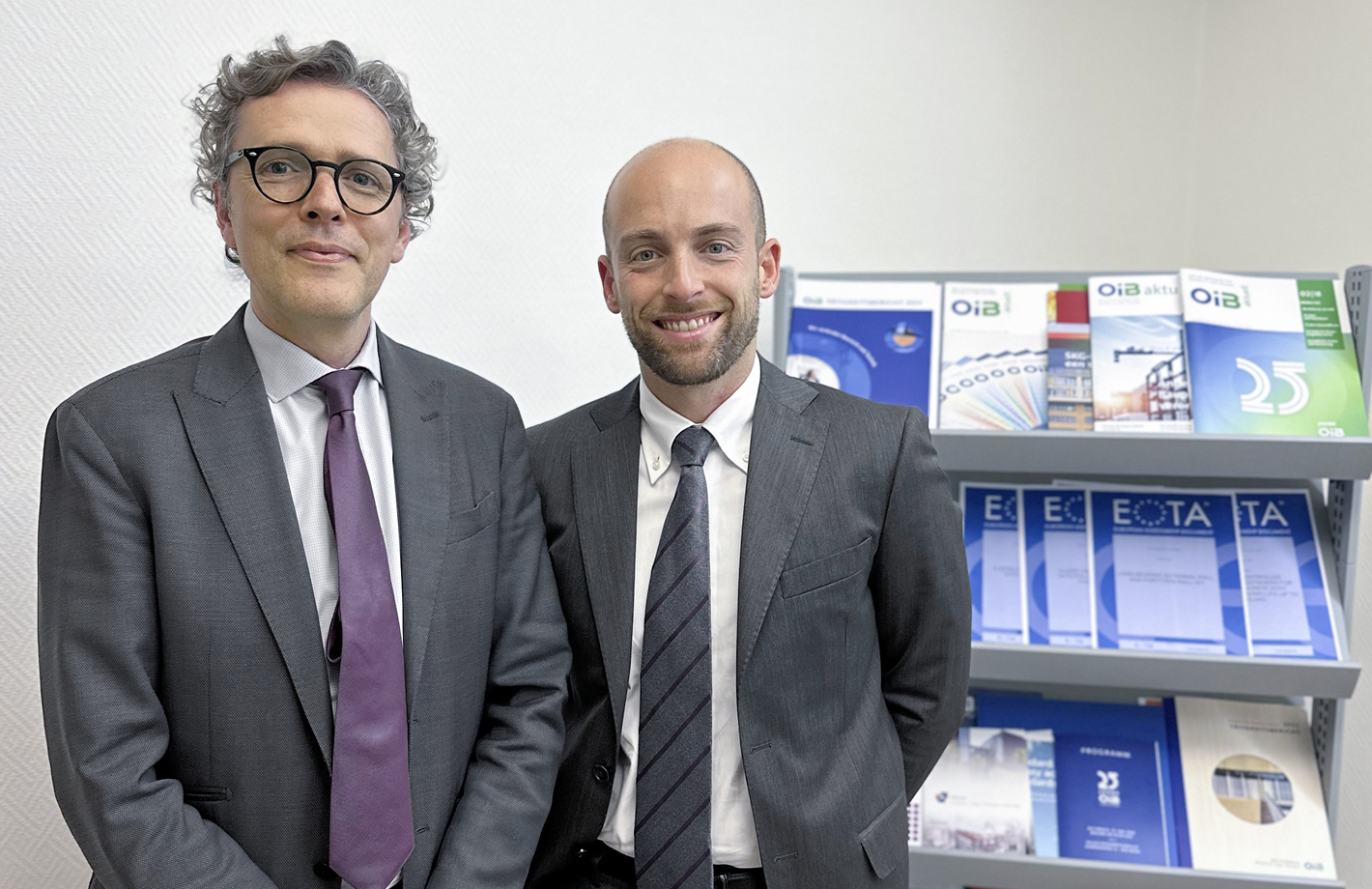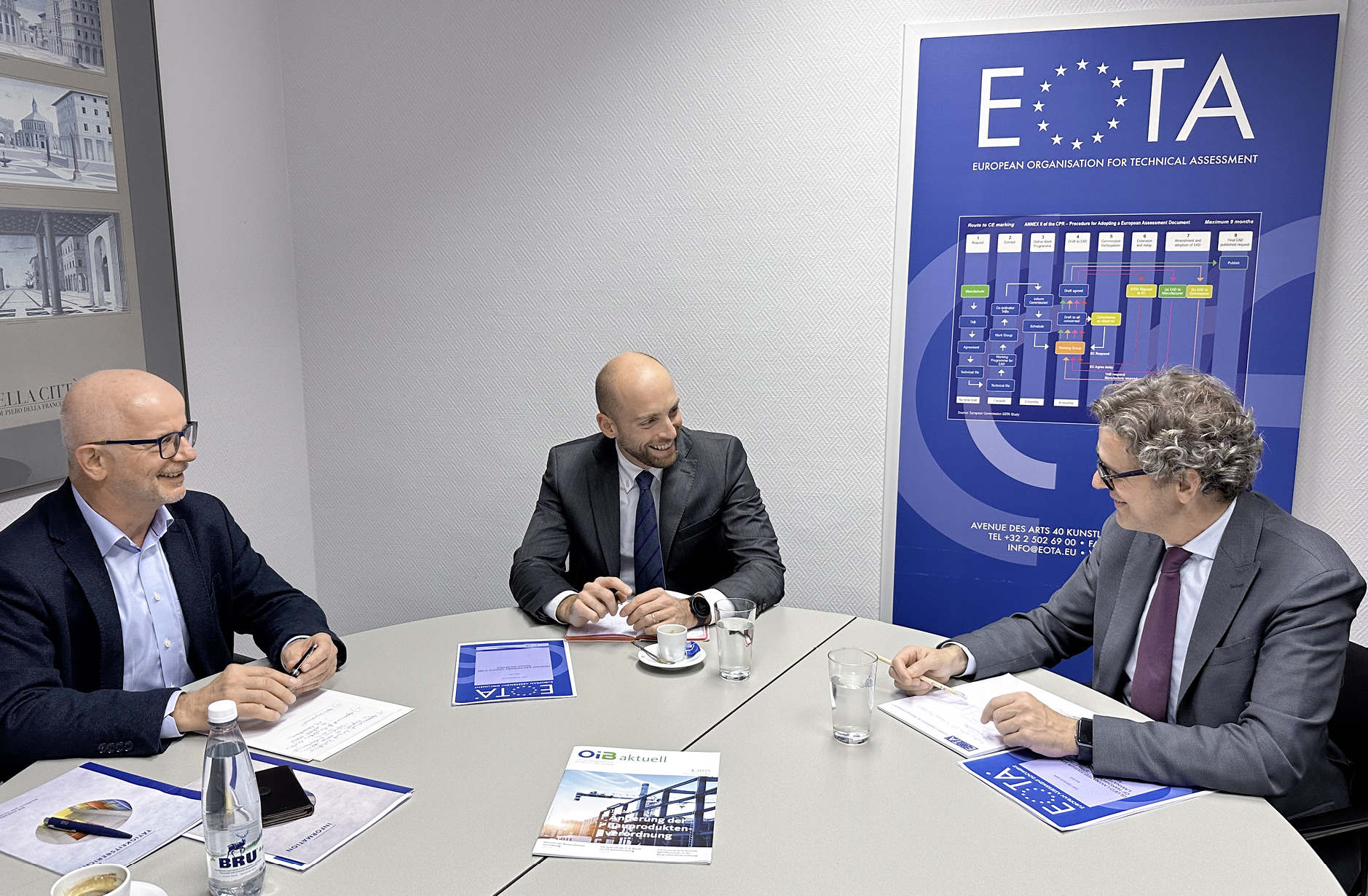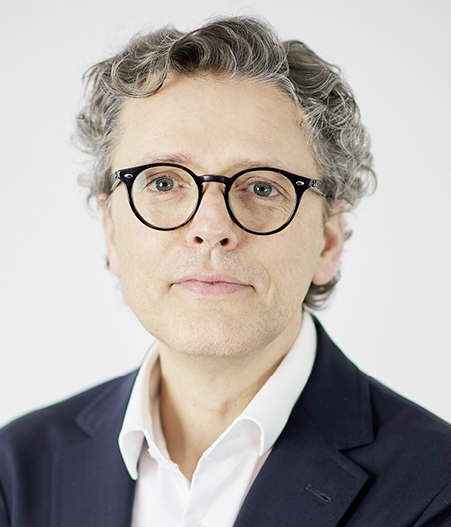Our member – Österreichisches Institut für Bautechnik (OIB) – published a double interview with Domenico Tinto, Seconded National Expert at the European Commission, and Sergio Vazquez, EOTA Secretary General. The original German version was published in the 4/2022 edition of OIB aktuell[1]. This translation is also courtesy of OIB.
Domenico Tinto, Seconded National Expert at the European Commission – Construction Products Regulation and Sustainable Construction, involved even in the consultation of European Assessment Documents (EAD) within the European Commission, as well as to Mr Sergio Vazquez. EOTA is the umbrella organisation of the Technical Assessment Bodies, designated by their Member States, as for example OIB, which are in charge of the elaboration and adoption of the European Assessment Documents and for issuing the European Technical Assessments (ETA).
With the proposal for a new Construction Products Regulation – which will repeal Regulation (EU) 305/2011 – published by the European Commission in March 2022 and currently under consultation on the level of the European Parliament and the Council, many questions are referring to the future CE marking. EOTA has already delivered detailed comments on this proposal for the area EOTA is in charge of. Now it’s the time to bring together the relevant proponents for a debate on the principles.
Moderator Georg Kohlmaier
Georg Kohlmaier: Mr Tinto, with this future Regulation the CE marking of construction products is going to be based somehow on “new feet”. What are the advantages to be expected for the industry in comparison to the current Regulation in use since 2013 from the point of view of the Commission? It is also noted that certain construction products, as for example “Construction products in contact with drinking water” or the product group „Road equipment: Circulation fixtures“, in future are intended to be excluded from the application of this Regulation. Is this correct? And Mr Vazquez, how do you evaluate from the point of view of EOTA the consequences of the new Regulation for the CE marking of innovative, non-standardised construction products, in particular, in relation to the procedure for the adoption of European Assessment Documents?
Domenico Tinto: I would say that “new feet” goes too far. The proposal maintains the performance-based approach of the current CPR, but at the same time reintroduces product inherent requirements related to safety or environmental impacts. It also empowers the Commission to complement or replace deficient standards. Let me clarify.
The proposal removes the limits of the pure performance approach. The CE marking will keep an element of continuity with the DoP and the performance-based approach, but add a possible novelty which is the Declaration of Conformity. It would declare the fulfilment of product requirements, some of which already exist in current standards. In addition, the new CPR proposal allows manufacturers to provide additional product information. This means that the future CPR can address each construction product regardless of its peculiarity.
In addition, let me highlight the consequences of the European court ruling C-613/14 that strengthened the legal requirements applying to harmonised technical specifications. Consequently, all new harmonised standards were evaluated under significantly more stringent rules and therefore, none of them published during the last four years. The proposal foresees the empowerment for the Commission to complement or replace deficient standards; if a new court ruling impacted the construction products sector and its harmonised technical specifications, this empowerment would avoid a new standstill.
The court ruling impacted also the development of EADs, causing considerable delays. The proposal for the new CPR will avoid this in future, because the EADs are not subject to the same stringent requirements as the hENs. At the same time, the ETA will still allow manufacturers to CE mark their products and no barrier can be set to their trade by any Member State. The EOTA route will also become more effective. EADs will not be subject to the rigid legal requirements applying to harmonised technical specifications. This will speed up EAD development and the European Commission scrutiny.
Furthermore, focusing more on products not covered by harmonised standards and allowing the European Commission and associations of manufacturers to request the development of new EADs, we expect to target better innovation and reduce the overall workload of EAD development. Finally, by empowering the European Commission to cite EADs with restrictions, manufacturers will have EADs cited faster in the Official Journal of the EU since controversial contents will be removed by the Commission without back and forth revisions of the EAD.
Summarising: the advantages of the new CPR to manufacturers will be a well-functioning internal market for construction products and a faster and more comprehensive route to CE mark also innovative products.
Regarding the products that are excluded from the scope of the proposal, there are several reasons behind this. Notably, either they did not profit significantly from the CE marking, or it was of no relevance for the basic works requirements for construction works, or they were covered by overlapping legislative initiatives.
Sergio Vazquez: The ETA route is a constituent of the new CPR proposal. This is a clear sign that the European Commission supports manufacturer-driven innovation as provided by the ETA route.
As with any legal proposal, there have been some relevant changes in the proposal. EADs are not considered to be part of the harmonised sphere anymore. Even though the idea is to make the system more flexible for those construction products that are not covered by a harmonised standard, the market can see this as a flaw in the route. To avoid unintended side-effects, the final CPR proposal should make it clear that EADs form part of the common technical language and Member States should make sure that they can be easily accommodated into their national systems.
Another point which should be revised is the timelines for greenlighting EADs at the level of the European Commission. Clear deadlines are needed in order to reach a reasonable timeframe. Without them, innovation is not possible.

Georg Kohlmaier: A key issue in the draft Regulation is the basic requirement for construction works „Sustainable use of natural resources of construction works”. What is the expectation for the Commission to focus on that? The implementation of the basic requirements no 7 and no 8 in harmonised technical specifications will probably last for a longer period. Would EOTA be in a position to provide for the sector of European Assessment Documents with a rather fast implementation in order to support the industry and construction workers?
Domenico Tinto: The new CPR alone cannot succeed in all current and future challenges. Proper implementation is vital. For this reason, without waiting for the new CPR to enter into force, the European Commission services are already working beyond the limit of the current CPR and considering the boundaries of the proposal. This work takes place in the CPR Acquis process, where the thematic subgroup on environmental sustainability started its work this October 2022. This subgroup works primarily on the issues that can facilitate implementation already under the current CPR (e.g. lack of an AVCP decision, environmental indicators under the current BWR7) and then will move to the potential novelties of the future CPR. Representatives from EOTA attended the first meeting of the subgroup and could provide a highly valuable contribution to this process. Considering the speed for developing EADs, there is a good potential in EOTA to pioneer the assessment of environmental sustainability performances.
Sergio Vazquez: EOTA presented a proposal to deal with basic requirement no. 7 in EADs following EN 15804 – Sustainability of construction works. What we are waiting for now is a decision on the AVCP system and the final feedback from the European Commission on our proposal and the CPR Acquis discussion. This will be assessed by our Project Team dedicated to sustainability, PT 12, in order to implement the proposal into EADs. As soon as the proposal is ready, manufacturers will have the possibility to have sustainability aspects included into EADs and consequently, into ETAs.

Georg Kohlmaier: The feedback we receive from manufacturers is that European Assessment Documents in terms of technical specifications and European Technical Assessments are becoming more and more relevant and popular for authorities and purchasers even outside of the European Union. How can the European Commission and EOTA promote the application of the rules of the Construction Products Regulation in terms of its content in non-EU countries?
Domenico Tinto: The EOTA route is voluntary; when a manufacturer undertakes this route it means that the product in question has great potential for cross-border trade. This tradability is a characteristic of the product itself, and if a product can cross the national borders within the EU, this means that there is a strong potential also to market it outside the EU. Therefore, from our side we need to improve the efficiency of the EOTA route and speed up the citation of new EADs: this will be achieved with the new CPR. However, we need also to strengthen diplomatic relations with candidate states and non-EU countries, and work together with DG NEAR[2] to speed up the assimilation of our Regulation in candidate countries, and with DG TRADE to extend further the market for construction products. I think that here, EOTA has to play a proactive role, identifying the main markets to target and cooperating with the competent EC services.
Sergio Vazquez: This is indeed a tendency we became aware of a couple of years ago. Manufacturers from 73 countries have requested ETAs for their construction products. Not only are ETAs relevant for the single market within the EU, but also in other countries. This is a clear message that the ETA route is a global tool for innovation in the construction sector developed in and by the EU.
EOTA is developing EADs in new product areas and more horizontal EADs in those areas that have already been dealt with. This approach will certainly engender new requests from global manufacturers.
Georg Kohlmaier: I would like to thank you very much for your participation in this interview and for giving insightful understanding on the topic from your point of view. With this the readers may have, on one hand, a better understanding on the background, and, on the other hand, a detailed information on expectations on the new Construction Products Regulation from both sites.
More about
Born in 1984 in Pomigliano D’Arco (Italy)
In 2010, he received a Master's degree in building engineering at the University of Napoli. After a specialization in sustainable technologies and a short period in the UK, he worked for the Italian Ministry of infrastructures and transports in the reconstruction of the city of L'Aquila, where he received a Master of Advanced study in seismic engineering. From 2018, he joined the European Commission working in the Unit responsible for the implementation of the Construction Product Regulation. He supported the team that prepared the Commission proposal for the new Construction Products Regulation adopted on 30 March 2022.

Born in 1975 in Seville (Spain). Received his degree as a Technical Architect in 1998 and a Master’s degree in Business Administration in 2011.
1998 – 2005: Project Manager in the construction sector.
Projects: Rubbish Collection San Diego (Seville), Rubbish Collection Pino Montano II (Seville) and Indoor Pool (Mairena del Alcor).
Quality and Environmental Systems
2005 – 2017: Technical and managerial positions in public administration (Spain).
Projects: Plan to Promote Agricultural Employment (PFOEA) and Restauration of Neighbourhood in El Torrejon (Huelva).
Technical Adviser in Health and Safety: Government Delegation, Delegation of Finance and Courts in Seville
Since 2015: Represents the General Council of Technical Architecture of Spain (CGATE) in the Consortium of European Building Control (CEBC) and the European Council of Construction Economists (CEEC).
Since 2017: Secretary General of EOTA.

Deputy Managing Director and Head of Department of OIB
Representative of OIB in the EOTA Executive Board,
EOTA Technical Board chairman 2013 – 2017.
